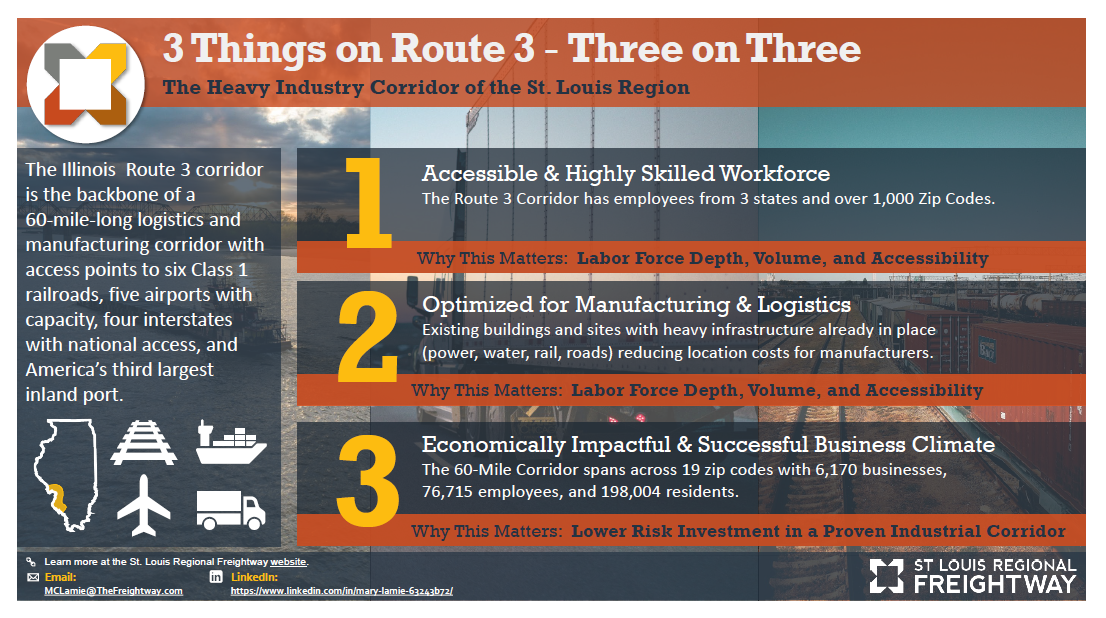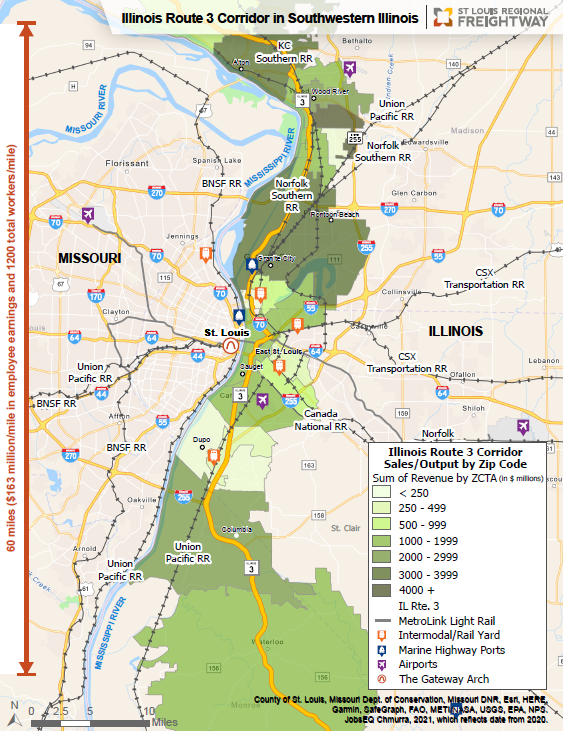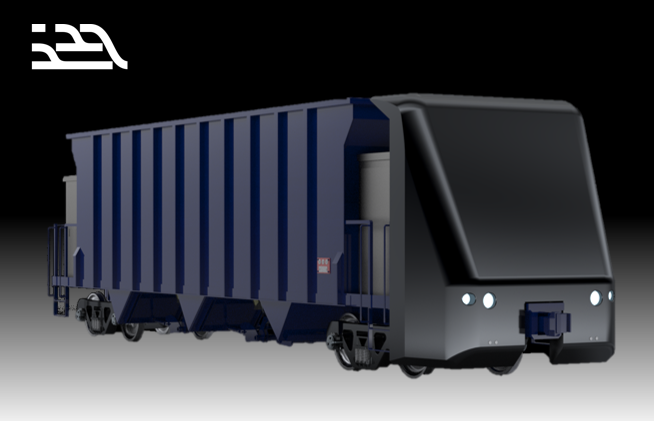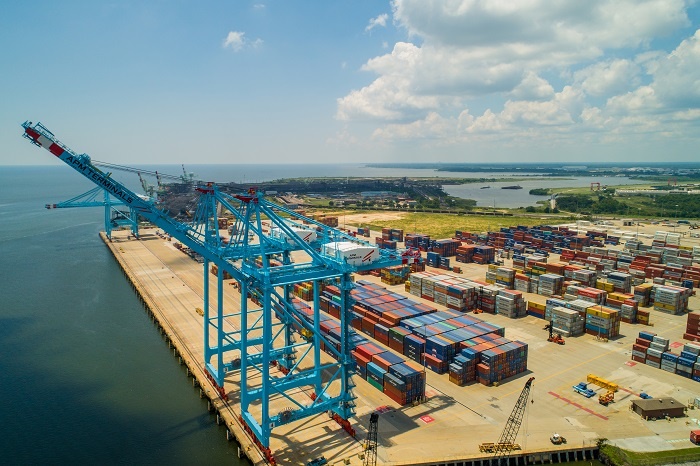
Thriving manufacturing and logistics hub generates $16 billion in annual revenue, supports nearly 222,000 jobs
A 60-mile stretch of Illinois (IL) Route 3 generates $16 billion in annual business revenue and supports 221,881 direct and indirect jobs, according to a new economic impact study commissioned by the St. Louis Regional Freightway. The Route 3 corridor in southwestern Illinois is parallel to St. Louis, Missouri along the Mississippi River and Interstate 255, and goes from Waterloo, Illinois, in the south to Godfrey Illinois, to the north. It is gaining recognition as a premiere heavy industry and warehousing corridor with distinct advantages over other areas around the country, such as the percentage of the direct jobs in manufacturing, transportation and warehousing that greatly eclipse the regional and national averages for jobs in those sectors.
“These concentrations and logistical connections make it a unique asset in the Midwest from a site selection point of view,” said Doug Rasmussen. “We do a lot of work throughout the country and in the Midwest, and we really view this as a premiere heavy industry and warehousing corridor with unique advantages.” Rasmussen is CEO and Managing Principal of Steadfast City Economic & Community Partners, the author of the recently completed economic impact study.
Rasmussen said that beyond the notable workforce concentration in the 60-mile corridor, it also offers extensive logistical connections via road, rail, air, and barge, and features heavy power infrastructure and supportive communities ideally suited for manufacturing and heavy industry. The corridor is dotted with steel mills, warehouses, soap and chemical plants, fuel blending and production facilities — both gas and ethanol, aerospace manufacturing, animal food companies, and many other concentrations.
The economic impact study indicated that the accessible, good-paying jobs that already exist in the Route 3 corridor attract workers from more than 1,000 different zip codes across three states, including Illinois, Missouri and Indiana. More than 22,000 of the workers are employed in the top two sectors within the corridor – manufacturing and transportation/warehousing – which respectively represent 14% and 13.8% of the total workforce. That is significantly greater than the St. Louis region and the United States, where manufacturing is just over 8% and transportation/warehousing is 5% of the total workforce. More than 20 types of manufacturing operations are present in the corridor, delivering a location quotient of 1.26 or more and indicating a noteworthy regional concentration.
“From an operating business view, being in an area with similar companies provides a competitive advantage and facilitates fewer business interruptions as it’s easier to fill vacancies with skilled and experienced labor, source new employees and attract suppliers,” Rasmussen said. “There is also a network of manufacturing training programs via nearby community colleges and universities to help feed the talent pipeline to address future workforce training needs.”
Intersect Illinois is the statewide economic development organization focused on bringing new businesses, jobs and investment to Illinois. The organization provides data, location assistance, and connections to companies considering growth in Illinois (at no cost).
“Route 3 has some tremendous assets and I’d encourage communities to leverage Intersect Illinois’ services so we can help them connect with companies interested in the area,” said Intersect Illinois Vice President of Business Development, Paulina San Millan said. “Also, it’s important for communities to promote their top marketable sites and have everything ready for those sites, including due diligence, studies and anything else that leads to site readiness. Intersect Illinois maintains a database of available real estate on our website, and it is a great resource for communities to market sites. ”
San Milan said consistent and proactive marketing in the Route 3 corridor is important because the demand is there. Opportunities abound to capture more steel and semiconductor manufacturing, according to San Millan. She said Illinois will soon sign the MICRO Act that incentivizes companies that manufacture microchips and their components, and that gives Illinois an advantage in that area.
Rising inflation is on the radar of site selection consultants, and San Milan said some consultants have seen projects put on hold and taking into account the increasing cost of developing facilities.
“The increasing costs might lead to new opportunities for areas that offer a lower cost,” San Millan said.
Rasmussen said those lower costs may be attainable in an area such as the Route 3 corridor, given the incentive tools available. Former Illinois State Senator James Clayborne who is a founding partner with the Clayborne & Wagner law firm, played a key role in the creation of the Rivers Edge program, the Neighborhood Redevelopment Corporation — also known as the East St. Louis Neighborhood Redevelopment Act (NRC) — and the New Markets Tax Credits.
“These three [incentives] are designed to help remove barriers to developing environmentally challenged areas. But, what’s even more important is the fact that all these are designed to leave it up to the developer to create what he or she believes will develop that area,” Clayborne said. “It allows them to plan it and provides the tools we believe will help incentivize opportunities for those developers. There’s a dividend income tax deduction, which allows individuals, corporations, trusts and estates to deduct an amount equal to dividends paid to them, by a corporation that conducts substantially all of their work within the River’s Edge development. It provides a material tax deduction, again, incentivizing those developers to come to the area.”
He said another incentive in Rivers Edge focuses on the lenders and allows the lenders to take an interest income deduction that allows financial corporations to deduct an amount equal to 25% of the project’s qualified rehabilitation expenses. In addition, he said, there’s also a sales tax exemption and benefits from historic tax credits.
Clayborne said it is important to continue to expand incentives such as Rivers Edge, and to make sure that it is being funded at a consistent level.
“With the NRC, you have the ability to be the conduit for development based upon controlling a certain area of land with the ability to write your story of how successfully this land could be utilized to be productive again, to create jobs and stimulate the economy,” said Clayborne.
Clayborne also said the State of Illinois invested more than $200 million last year towards potentially transformational projects in the southwestern Illinois area that is home to the Route 3 corridor. “The current administration and the governor have been engaged and have set $1.8 billion aside for economic development to address some of the issues that currently exist in revitalizing and redeveloping land that in the past has not been focused on because of environmental issues. The other issue that’s very important is we also have the labor to be able to get these projects completed, done on time and done in an efficient manner.”
Mary Lamie, Executive Vice President of Multimodal Enterprises for Bi-State Development and head of the St. Louis Regional Freightway, said the economic impact study findings are a call to action for the region.
“We’ve talked about how we do have sites that are developer already that are in close proximity to this corridor, and that’s where we’re going to continue to ramp up our story utilizing this information,” Lamie said. “More importantly, the call to action is for the sites that aren’t quite developer ready. I can’t think of a better time to start working with those community leaders to try and find ways that we could really maximize the tools that Senator Clayborne talked about in regards to the incentives available. We have the economic study that shows we have the metrics that support that this is one of the best locations in the nation. We have the labor and we have the geographic advantages of the infrastructure all in place.”
Clayborne, San Milan, and Lamie participated in a panel discussion moderated by Rasmussen that focused on the Route 3 corridor economic impact study. The panel discussion was part of FreightWeekSTL 2022, held virtually May 23 through May 27. The fifth annual event featured panel sessions with industry experts and leaders in freight, logistics and transportation and was presented by the St. Louis Regional Freightway and Bi-State Development in conjunction with The Waterways Journal. To learn more or view past sessions for FreightWeekSTL 2022, visit www.freightweekstl.com. An overview of the economic impact study data can be found here.





